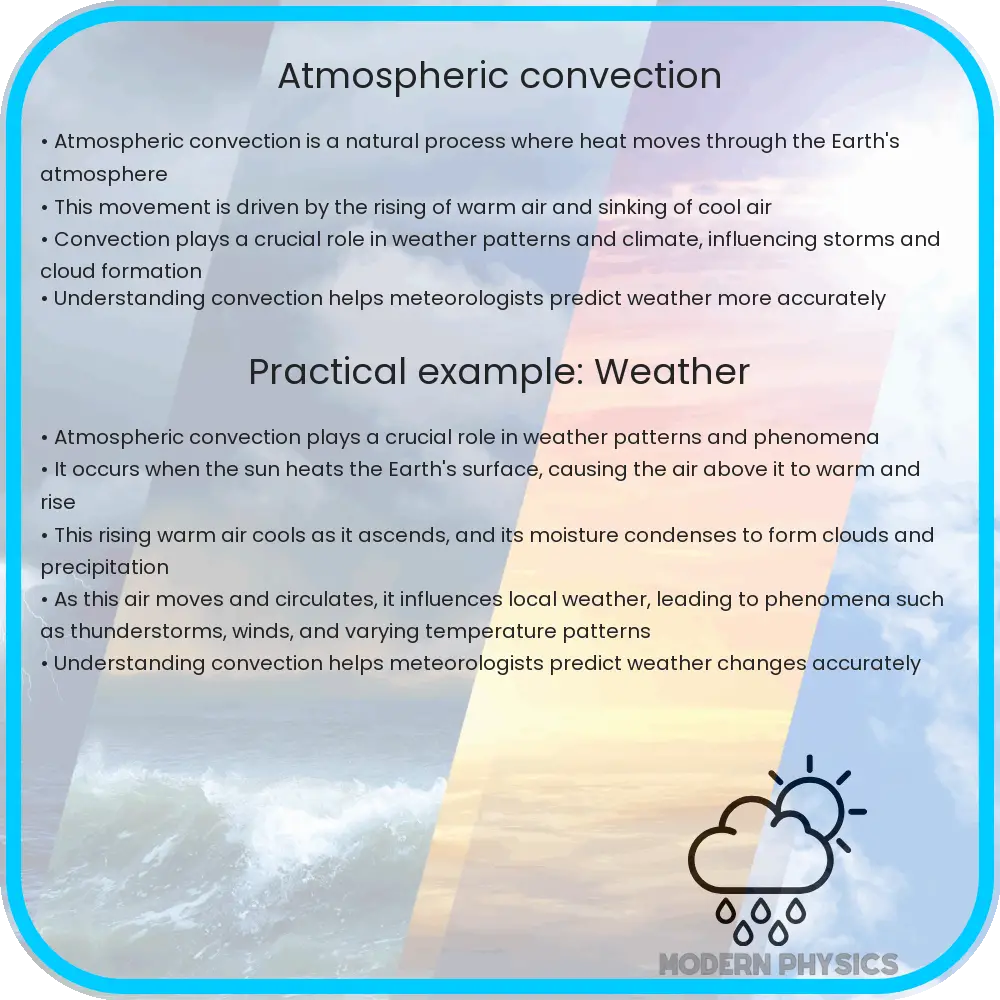Explanation of atmospheric convection, a key process affecting weather and climate by the movement of heat from Earth’s surface to the atmosphere.

Understanding Atmospheric Convection
Atmospheric convection is a fundamental process that drives weather patterns and influences climate systems around the world. Fundamentally, it involves the movement of heat from the Earth’s surface into the atmosphere, spurred by the warming of the ground by solar radiation. This article explores the dynamics of atmospheric convection, its predictability, and its impact on global climate.
The Dynamics of Atmospheric Convection
Convection in the atmosphere occurs when air near the Earth’s surface is heated, becomes less dense, and rises. As it rises, it cools and can condense into clouds, leading to various weather phenomena including rain, storms, and even hurricanes in more extreme cases. There are two primary types of atmospheric convection: free convection and forced convection.
- Free Convection: This type occurs when air is heated directly by contact with a warmer surface, such as land heated by the sun, leading to upward motion because warm air is lighter than cold air.
- Forced Convection: Happens when winds push air over a surface with a different temperature, causing it to rise and create weather patterns as it interacts with the upper atmosphere’s temperatures.
Predicting Atmospheric Convection
Prediction of atmospheric convection is crucial for weather forecasting. Meteorologists use various models and tools to analyze temperature, humidity, atmospheric pressure, and other data to predict when and where convection might occur. One of the most common tools is the skew-T log-P diagram, which plots the temperature and dew point of the air as it rises and helps forecasters identify potential for convection.
Climate Impact of Atmospheric Convection
Convection plays a significant role in regulating the Earth’s climate. It aids in the distribution of heat across different parts of the planet and contributes to the hydrological cycle by transporting moisture into the upper atmosphere, where it can condense into precipitation. Convection currents can transport pollutants and other particulates vertically within the atmosphere, influencing air quality and climate patterns.
Additionally, large-scale convective activities, such as those found in the Intertropical Convergence Zone (ITCZ), heavily influence the climate of tropical areas by creating bands of clouds and storms, contributing to the rainfall patterns observed in these regions.
Understanding the Role of Atmospheric Instability in Convection
_x000D_
Atmospheric instability plays a crucial role in the development of convection. This instability occurs when warmer, lighter air is trapped under cooler, denser air. When the warm air finds an opening, it rises rapidly through the cooler air, leading to the formation of convection currents. Several factors can increase atmospheric instability, such as differences in air temperature between adjacent air masses, or the heating of the Earth’s surface by the sun during the day.
_x000D_
_x000D_
Human Activities and Convection
_x000D_
Human activities can also influence atmospheric convection. Urbanization, for instance, modifies land surfaces and can alter local convection patterns. Cities with large amounts of concrete and asphalt absorb and retain heat, a phenomenon known as the urban heat island effect. This can enhance local convection, leading to more frequent thunderstorms in urban areas compared to their rural surroundings. Similarly, pollution can affect convection by adding particles to the atmosphere that serve as nuclei around which moisture can condense.
_x000D_
_x000D_
Technological Applications of Atmospheric Convection
_x000D_
Understanding atmospheric convection is not only crucial for weather prediction and climate studies but also has practical applications in technology. For example, engineers use knowledge of convection to design better ventilation systems in buildings, improving air circulation and energy efficiency. In aviation, pilots use forecasts of atmospheric convection to avoid turbulent areas, ensuring safer and smoother flights.
_x000D_
_x000D_
Conclusion
_x000D_
Atmospheric convection is a complex and dynamic process that significantly impacts the weather patterns and climate across our planet. By exploring the mechanisms behind free and forced convection, understanding the role of atmospheric instability, and looking at human impacts and technological applications, we can appreciate how essential this process is to our daily weather and overall climate. Advancements in technology and continued research will further enhance our ability to predict convection patterns, ultimately leading to better responses to its impacts on local and global scales.
_x000D_
_x000D_
As we continue to explore and understand the intricate dynamics of our atmosphere, convection remains a central topic that illustrates the fundamental principles driving much of the Earth’s weather and climatic processes. It also exemplifies the interconnectedness of natural processes and human activities, prompting us to consider more sustainable practices to mitigate adverse impacts on weather and climate.
